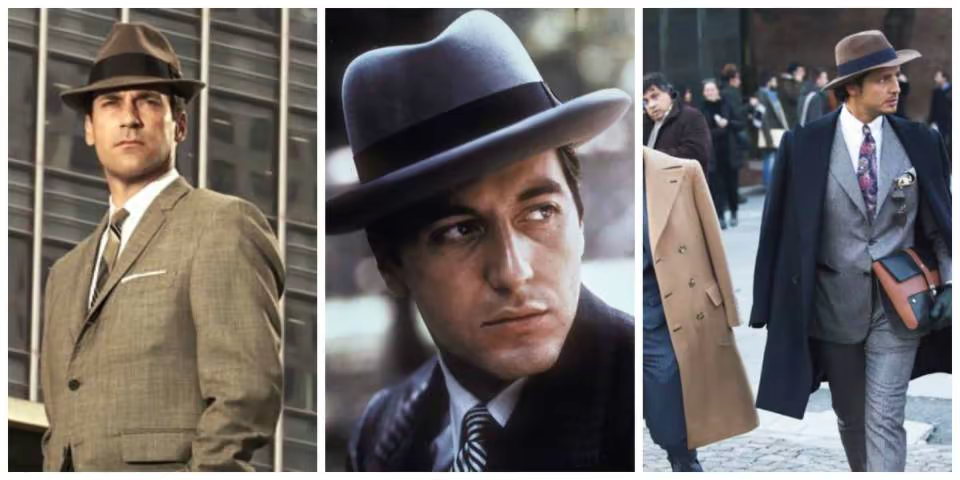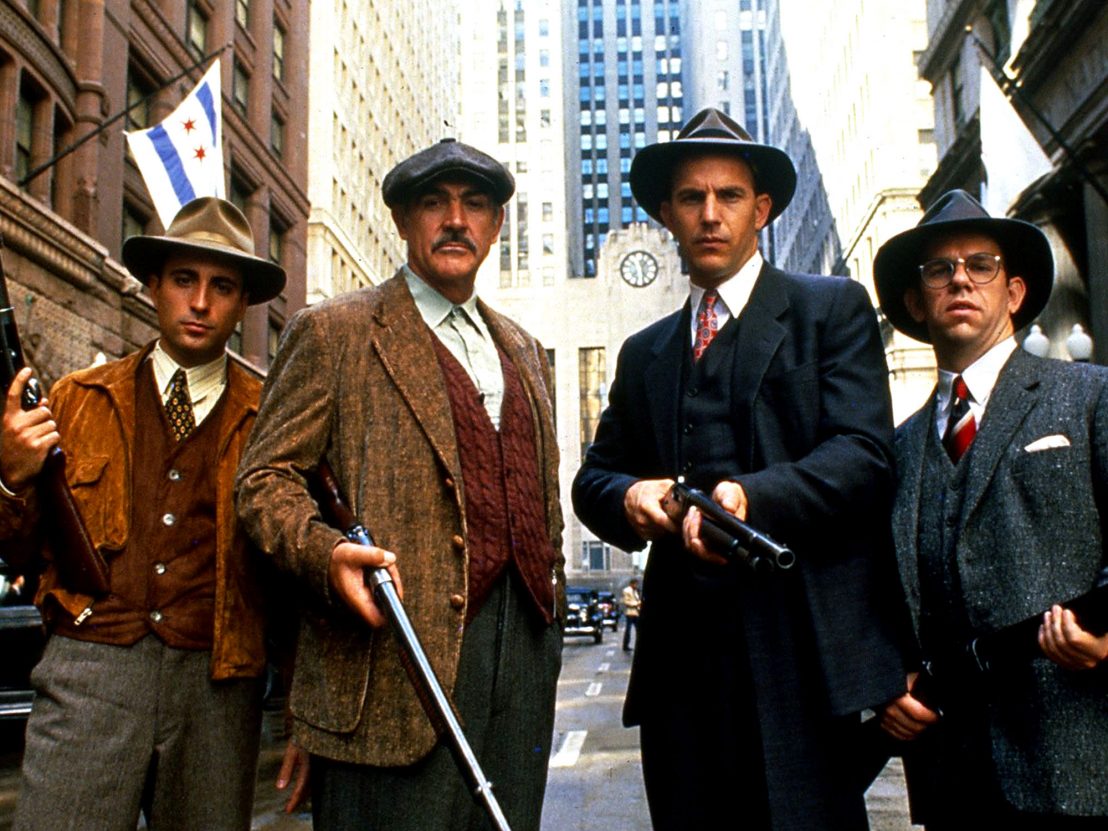1940s Fashion Men: What Did Guys Wear In The 1940s?

In the 1940s fashion men had a distinctive look. Most guys wore suits that had wide shoulders and high-waisted pants. These suits were usually made with fabrics like wool, and the lapels on the jackets were quite wide. To complete the look, men would wear neckties, which were often wide and came in bold patterns.
Shirts were mostly white or pastel-coloured, with long collars that pointed out. Hats were a big part of men's style, and fedora hats were very popular. On their feet, men wore lace-up oxford shoes, typically in brown or black leather.
World War II had a significant influence on fashion, and military-style clothing like khaki pants and bomber jackets became trendy. For 1940s men’s casual wear occasions, high-waisted trousers, knitted sweaters, and sports jackets were common choices.
Hairstyles were typically short and slicked back, often with a side part. It's important to remember that fashion could vary depending on where you lived, your social status, and personal preferences, but these trends give us a good idea of what guys wore in the 1940s. The 1940s were a decade marked by distinctive fashion trends, heavily influenced by World War II and the need for practicality.
What Type Of Clothing Was Popular In The 1940s?

source: google.com
Suits: 1940s fashion men were characterised by a strong, masculine silhouette. Jackets had wide shoulders and padded chests, creating a V-shaped look. The trousers were high-waisted and often had pleats, and cuffs at the bottom. This tailored look was a staple for men, whether for work or special occasions.
Ties: Neckties were a crucial accessory. They were wider than today's ties and came in bold patterns, adding a pop of colour and personality to the otherwise conservative attire.
Read Also: 80s Winter Fashion Trends: 1980s Winter Fashion Outfits for Ladies
Shirts: Dress shirts were typically white or pastel-coloured with long, pointed collars. French cuffs, where the cuffs were folded back and fastened with cufflinks, were also popular for formal occasions.
Hats: Men wouldn't step out without a hat, and the fedora was the iconic choice. These hats came in various colours and materials, often completing the polished look of a well-dressed man.
Shoes: Lace-up oxford shoes were the norm, either in brown or black leather. They were a versatile choice that could be worn with both formal and casual outfits.
Military Influence: Due to World War II, military-inspired clothing became fashionable. Khaki pants and bomber jackets, similar to those worn by servicemen, gained popularity among civilians.
Casual Wear: For more relaxed settings, men often donned high-waisted trousers paired with knitted sweaters or sports jackets. This look offered comfort and a touch of sophistication. Men typically sported short, slicked-back hairstyles. Hair was often side-parted and neatly combed.
Women's Fashion: Women's fashion in the 1940s was defined by practicality due to the war. Daytime attire for women often included knee-length A-line dresses with padded shoulders, while evening gowns featured elegant silhouettes with draped fabrics. Nylon stockings and platform shoes were also in vogue.
Makeup and Hairstyles for Women: Victory rolls and pin curls were popular hairstyles, and makeup was minimal due to rationing. Red lipstick, however, remained an iconic beauty statement.
To sum up everything that has been stated so far is that 1940s mens casual wear were characterised by a blend of military influence, tailored elegance, and a sense of practicality. It was a time when people adapted their clothing to the challenges of wartime, resulting in a unique and enduring style that still influences fashion today.
10 Tips for Looking Fabulous in a 1940s Fashion Man
Choose the Right Suit: The 1940s suit had a distinctive silhouette. Jackets featured wide shoulders, a padded chest, and wide lapels. Trousers were high-waisted with pleats and cuffs at the bottom. Opt for classic colours like navy or grey, or explore pinstripe patterns for added flair. Tailoring is key; ensure the suit fits well to accentuate the masculine shape.
Choose the right tie : In the 1940s, ties were wider than modern ones and came in bold patterns. Consider polka dots, stripes, or geometric designs. The tie should complement your suit while adding a touch of personality to your look.
Shirt Selection: Dress shirts in the 1940s were typically white or pastel-coloured. They had long, pointed collars that added elegance to the ensemble. Make sure the shirt fits comfortably and tucks neatly into your trousers. French cuffs with cufflinks were also popular for formal occasions.
Read Also: 1950s Men's Outfits: How to Dress Like The 50s Male?
Don a Fedora: The iconic fedora hat completed the 1940s look. Choose a fedora that suits your outfit; wool or felt fedoras were common for formal occasions, while straw fedoras were great for summer. The hat not only adds style but also protects you from the elements.
Proper Footwear: Lace-up oxford shoes were the preferred choice, coming in brown or black leather. Keep them polished and well-maintained to maintain a polished appearance. Ensure they match the formality of your outfit.
Military-Inspired Pieces: Due to World War II's influence, military-style clothing became fashionable. Consider adding khaki pants or a bomber jacket to your wardrobe. These pieces bring a rugged yet stylish edge to your look.
Perfect Your Casual Attire: For casual occasions, high-waisted trousers, knitted sweaters, and sports jackets were common choices. This combination offered comfort and a relaxed yet refined appearance. Look for quality materials and well-tailored pieces.
Groom Your Hair: Achieving the 1940s fashion men hairstyle is essential. Men typically had short, slicked-back hair. Use pomade or gel to keep your hair in place and create a neat, tidy appearance. A side part adds authenticity to the look.
Accessories Matter: Pay attention to the details. Cufflinks, tie pins, and pocket squares can elevate your outfit. Coordinate these accessories with your suit and tie to achieve a cohesive appearance.
Confidence is Key: Finally, exude confidence when wearing 1940s fashion. The men of that era carried themselves with self-assuredness, which added to their charm. Walk with confidence, maintain good posture, and wear your outfit with pride.
Understanding these detailed tips into your 1940s fashion men shirts trends look will help you achieve an authentic and fabulous appearance reminiscent of this classic era in fashion. Whether you're dressing up for a special event or embracing this style in your daily life, attention to these nuances will make your look truly remarkable.
Which men's fashion style became very popular in the 1940s?
In the 1940s fashion trends , there was a trendy men's fashion style called the "zoot suit." Here's what made it stand out:
Big Jackets: Zoot suits had really big jackets with wide shoulders. Imagine a jacket that's much larger than what you'd normally wear.
Baggy Pants: The pants that went with these suits were super baggy. They were loose and went up high on the waist, and they got narrower near the ankles.
Bright and Bold: Zoot suits loved bright colours and eye-catching patterns. So, you'd see suits with stripes, checks, or really vivid colours like red or yellow.
Cool Accessories: To complete the look, people wore cool accessories like wide-brimmed fedora hats, pocket watches hanging from chains, and nice dress shoes.
Inspired by Music: The zoot suit style was all about being influenced by music, especially jazz. It was a way for people to express themselves and be unique.
Some Drama: Zoot suits were sometimes connected to social issues. There were arguments and even fights between young people who wore zoot suits and soldiers during World War II. This led to something called the "Zoot Suit Riots" in 1943.
So, in simple terms, zoot suits were these really big, colourful, and stylish outfits that were popular in the 1940s fashion men and they often had a connection to music and some social tension.
By: Chetali Pandey
